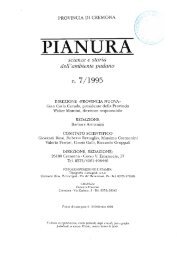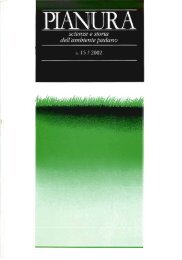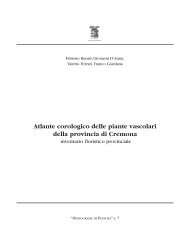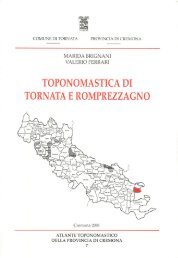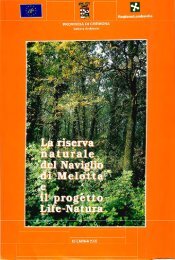Scarica il numero in pdf - Biblioteca digitale - Provincia di Cremona
Scarica il numero in pdf - Biblioteca digitale - Provincia di Cremona
Scarica il numero in pdf - Biblioteca digitale - Provincia di Cremona
Create successful ePaper yourself
Turn your PDF publications into a flip-book with our unique Google optimized e-Paper software.
Conclusioni<br />
polazioni <strong>di</strong> brugo: ne consegue che <strong>in</strong>terventi <strong>di</strong>retti atti a favorire<br />
<strong>il</strong> processo <strong>di</strong> rigenerazione sono urgenti. La durata della<br />
vita <strong>di</strong> una pianta <strong>di</strong> C. vulgaris è <strong>in</strong>fatti limita a circa 25 anni e<br />
un’età <strong>di</strong> poco superiore a 30 sembra essere <strong>il</strong> valore massimo<br />
normalmente raggiunto (GIMINGHAM 1960).Considerando <strong>il</strong> ciclo<br />
riproduttivo dei cespugli <strong>di</strong> brugo (GIMINGHAM 1987), non si ravvisa<br />
una vigoria nelle popolazioni locali tale per cui possa avvenire<br />
la rigenerazione vegetativa dei cespugli <strong>in</strong> fase sen<strong>il</strong>e, forse<br />
<strong>in</strong> relazione alle particolari con<strong>di</strong>zioni fitoclimatiche al limite <strong>di</strong><br />
quelle tollerate dalla specie nonché all’estrema competitività <strong>di</strong><br />
altre piante come alberi e arbusti, <strong>in</strong> particolare le specie esotiche<br />
<strong>in</strong>vasive (es.: Rob<strong>in</strong>ia pseudoacacia e Prunus serot<strong>in</strong>a).<br />
Occorre <strong>in</strong>oltre r<strong>il</strong>evare che la capacità <strong>di</strong> recupero vegetativa<br />
del brugo <strong>di</strong>m<strong>in</strong>uisce <strong>in</strong> seguito al raggiungimento dello sta<strong>di</strong>o<br />
<strong>di</strong> maturità (HOBBS & GIMINGHAM 1984; CALVO et al. 2005) ed <strong>in</strong><br />
particolare dopo i 15 anni (KAYLL & GIMINGHAM 1965); pertanto<br />
occorre <strong>in</strong>tervenire anticipatamente, se possib<strong>il</strong>e, a presc<strong>in</strong>dere<br />
dal tipo <strong>di</strong> tecnica gestionale da praticare.<br />
Il presente stu<strong>di</strong>o ha consentito <strong>di</strong> valutare la consistenza<br />
dell’habitat <strong>di</strong> brughiera nella parte coll<strong>in</strong>are e planiziale della<br />
prov<strong>in</strong>cia <strong>di</strong> Como e nel Parco Brughiera Briantea. Il territorio<br />
complessivo occupato da questa particolare vegetazione è attualmente<br />
irr<strong>il</strong>evante (0.07%). Le brughiere ricoprono <strong>in</strong>fatti lo<br />
0.94% della superficie che potenzialmente potrebbero ancor oggi<br />
occupare; le aree protette <strong>di</strong> fatto non si <strong>di</strong>scostano molto da<br />
questi valori.<br />
Si desume qu<strong>in</strong><strong>di</strong> <strong>il</strong> complessivo carattere relittuale <strong>di</strong> questo<br />
tipo <strong>di</strong> vegetazione, da ricollegarsi sia alle vicissitud<strong>in</strong>i storiche<br />
che hanno portato alla “redenzione” dei terreni <strong>di</strong> brughiera per<br />
ut<strong>il</strong>izzo agricolo e soprattutto selvicolturale, sia al relativamente<br />
recente e generale abbandono della gestione cap<strong>il</strong>lare del territorio<br />
con meto<strong>di</strong> tra<strong>di</strong>zionali e pratiche secolari, come lo sfalcio<br />
per la raccolta dello strame <strong>di</strong> brugo, <strong>il</strong> pascolo, <strong>in</strong> particolare<br />
ov<strong>in</strong>o, e non ultimo l’impiego del fuoco, ad esempio con l’esercizio<br />
del debbio, ben altra cosa rispetto agli <strong>in</strong>cen<strong>di</strong> <strong>in</strong>controllati<br />
<strong>di</strong> natura accidentale o più spesso dolosa che percorrono oggigiorno<br />
gli ambienti naturali.<br />
In questo contesto emerge purtroppo anche la scarsa qualità<br />
botanico-naturalistica complessiva delle brughiere. La superficie<br />
me<strong>di</strong>a occupata da una brughiera è <strong>di</strong> 0.32 ha e <strong>il</strong> grado <strong>di</strong> arbustamento,<br />
<strong>in</strong>versamente proporzionale allo stato <strong>di</strong> conservazione<br />
della brughiera, ha raggiunto un tale livello che me<strong>di</strong>amente<br />
un quarto della superficie delle brughiere è oramai occupato da<br />
piante arbustive (<strong>in</strong> prevalenza P<strong>in</strong>us sylvestris, Cytisus scoparius,<br />
Frangula alnus, Betula pendula e Populus tremula).<br />
35



